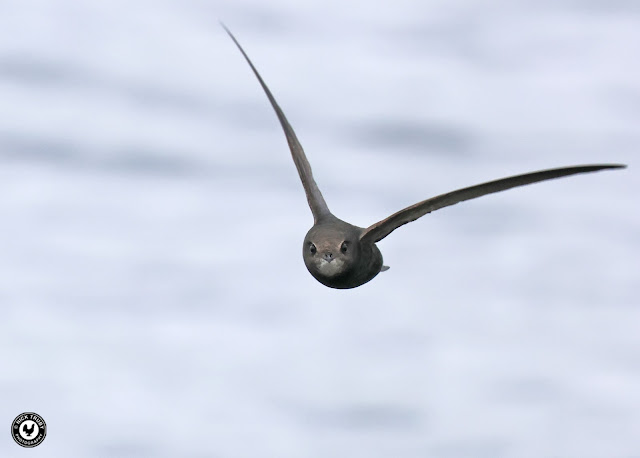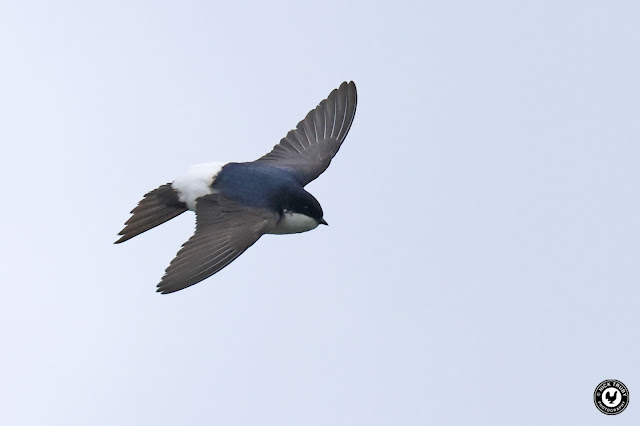The end of April is the time when what I call "The Spring Quartet", made up of Swifts, Swallows, House Martins, and Sand Martins, return to the UK. Although I shouldn't wish my life away, I eagerly look forward to the return of those four elegant denizens of the sky, and especially the Swifts. Swifts may not be much to look at, with their plain brown plumage, but they are the most "birdy" of all birds, in that they spend the vast majority of their lives on the wing, effortlessly scything through the air in their hunt for flying insect food.
Farmoor reservoir isn't the great birding place it used to be, it doesn't seem to attract the number or variety of birds that it did five years ago, I blame the increase in people based activity on the water, like paddle boarding, and off the water with many more folk taking daily constitutionals around the reservoir. There is also a growing problem of birds not being reported promptly to the wider birding community, a sad trait that appears to be getting more common these days at many sites in Oxfordshire, which often results in a good bird departing before others can see it. At certain times though, Farmoor excels, and a wet and windy forecast at the end of April is one of those times. The weather on both Saturday and Sunday promised to deliver the goods, and so it proved. Along with Mrs Caley, I spent a couple of hours on both mornings braving the elements while I attempted to nail some decent photos of all of the aforementioned birds.
On Saturday the wind was from the north-west, which brought drizzle and rain, and it was decidedly chilly too. Numbers of hirundines were notable with over two hundred Swallows and Sand Martins, and maybe just twenty or so House Martins. Initially it appeared as if I'd misjudged my optimism for a "Swift Day" but as we neared the causeway hide, I could see a few high up over the western end of the reservoir, and by mid-morning around fifty or so had descended to feed over the reservoir. There was hardly anybody else walking around the reservoir. In the hide was our friend Ewan, a Farmoor stalwart and all-round excellent birder. We chatted about what was about and what to expect. Ewan thought there would be a good chance of some Arctic Terns dropping in at some point. I was hopeful for some Black Terns as well. A few hours later it would become apparent that Ewan was a better forecaster than I am, since on our second visit to the hide, Mrs Caley found some Arctic Terns along with a couple of Little Gulls. My focus however, was on the fast flying "Spring Quartet".
Sunday was dryer although we did have to weather a couple of showers. The wind had shifted to the north-east but it was just as cold when stood out on the causeway photographing. The numbers of birds had increased too with over a hundred Swifts, a couple of hundred House Martins, and even larger numbers of Swallows and Sand Martins.
 |
| Swallow |
On both days we walked to the hide at Pinkhill where we watched the antics of cavorting Tufted Ducks and witnessed fleeting visits from a pair of Kingfishers that had showed superbly to others during the week. We also checked the lock area for Grasshopper Warblers but to no avail.
 |
| Tufted Duck |
As well as the dynamic Swifts and hirundines, there were other birds around the reservoirs, most notably Yellow Wagtails, our first of the year, with six on the Saturday increasing to over a dozen on Sunday. A Dunlin was present on both mornings, as were a couple of typically elusive Common Sandpipers.
 |
| Yellow Wagtail |
Swifts were my main focus on Saturday. The fifty or so of, in my opinion, one of the best of all birds, were bombing along the environs of the causeway at full pelt and offered a challenge that I couldn't refuse. Poor weather entails that the Swifts have to feed close to the water because the gnats and flies that they live on, can hardly get airborne. That gives the opportunity to get eye-level images as they speed past. It isn't easy to capture them and you have to get your "eye in", and anticipate which birds are going to pass close enough to give the chance of sharp photos. Exposure is tricky too. Swifts are dark birds against a light grey watery background so the camera needs setting for over exposure, which lowers the shutter speed. ISO has to be increased so that the shutter speed remains high enough for detail on a fast moving bird to be retained and for blur to be kept to a minimal, but raising the ISO also makes for grainier results. Much editing in Photoshop is required afterwards. It's much easier to photograph Swifts against the sky but generally you only capture the underneath of the bird which is less appealing.

 |
| Swift |
The two Martin species are the easiest to track and follow but are smaller so consequently more difficult to focus on unless very close to the camera. Sand Martins tend to hug the surface of the water whereas House Martins appear to like hunting over the causeway and embankment walls. It's easier to focus on birds flying over the uniform background of water or sky than the messy one of the road and walls. There will be better days for photographing the hirundines during the summer since they feed lower than the Swifts which in good weather always fly up high to feed.
 |
| House Martin |
 |
| Sand Martin |
On both days we saw Yellow Wagtails. It's hard to miss them with their vivid yellow breasts shining like beacons on grey days. They were quite flighty, birds in flocks always are, but occasionally one would stand still for a while on the causeway. On Sunday I struck lucky because just as I pressed the shutter button to capture a male stood on the embankment, a Swallow appeared and buzzed it into the air.
The only waders present were a single Dunlin and a couple of Common Sandpipers. Dunlin are always confiding, the Sandpipers less so. On their breeding grounds up in Scotland, Common Sandpipers will allow close approach but the opposite is true at Farmoor and generally they are only seen at distance or flying across the reservoir. The hoped for Sanderling and other waders didn't materialise.
 |
| Dunlin |
The Arctic Terns, our first for the year, and Little Gulls were feeding way out on F1 and none came close enough for realistic photo opportunities. We'd already seen some nice Little Gulls at Wilstone reservoir earlier this year and Arctic Terns are readily available in Scotland where we'll be heading soon!
 |
| Little Gull (Druridge Pools 30-05-2022) |
We couldn't find, or even hear, any Grasshopper Warblers at Pinkhill despite two being reported on the Saturday. Admittedly my ears don't cope that well with their reeling song these days but Mrs Caley will still pick them up easily so they must have been quiet if present. Other warblers, such as Blackcap, Common Whitethroat and Cetti's warbler were all singing but in the dreary conditions I didn't waste any time trying to photograph them. They are birds that require a nice day.
 |
| Blackcap (Burghfield Common 16-04-2022) |
The "showy" Kingfishers also shunned us somewhat, giving just a couple of flypast views and one distant perched bird. There will be better days for seeing them as well. There are still reasonably good numbers of Kingfishers in Oxfordshire so if you know where to go then you'll be sure to see them.
 |
| Kingfisher |
It made a nice change to be birding locally again after doing far too much travelling over the past couple of years. I didn't expect to be spending the whole weekend at Farmoor but when the Swifts are flying low then it's hard to resist!































No comments:
Post a Comment